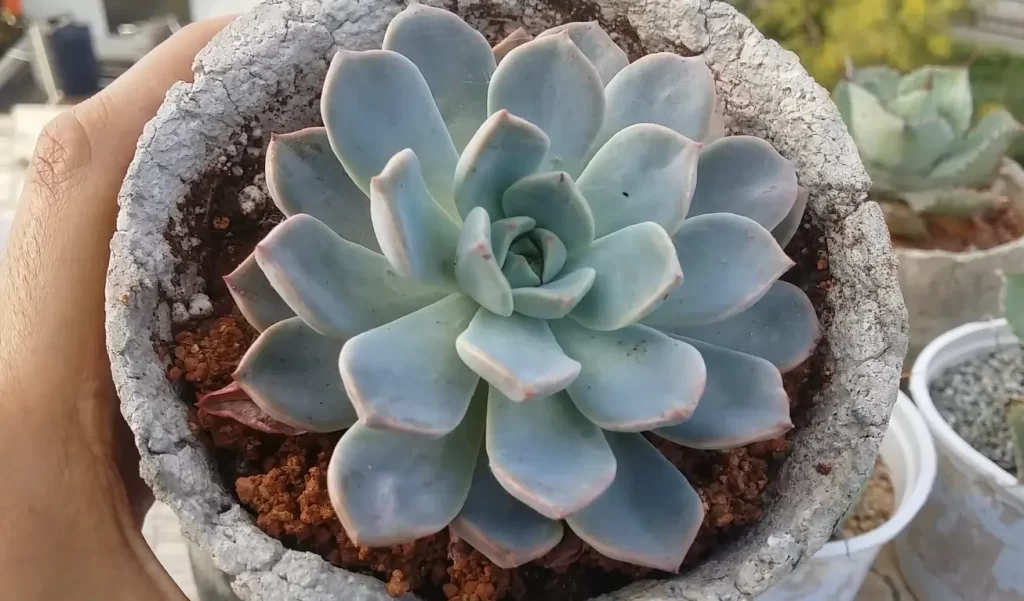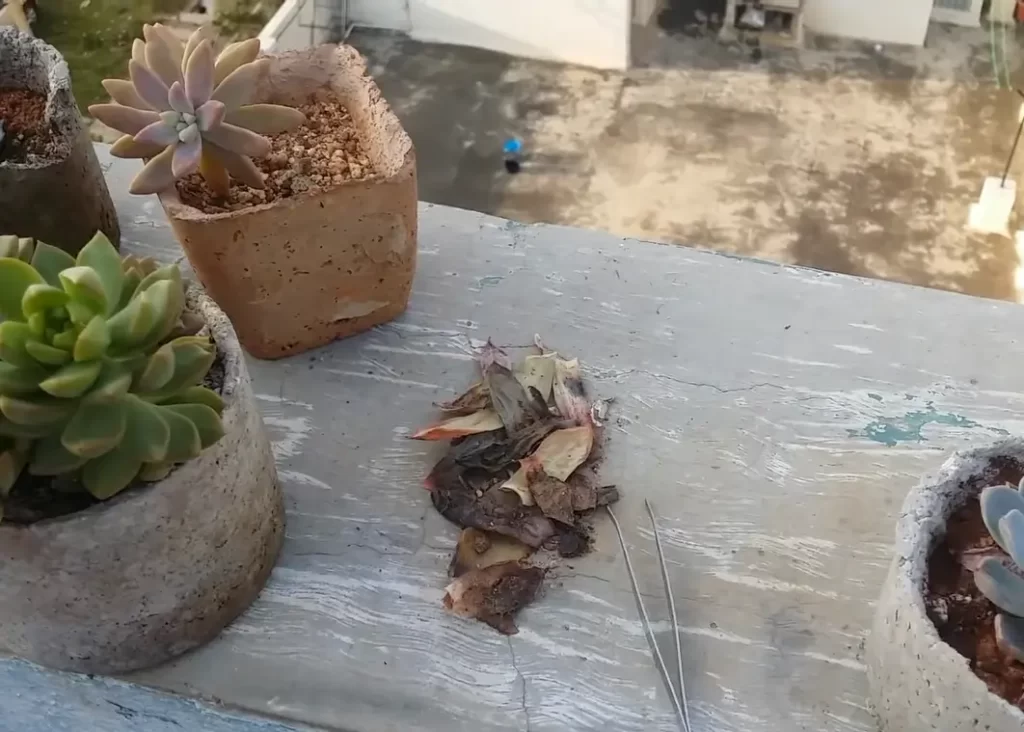Why Are My Succulents Turning Brown? Causes and Solutions
Have you ever looked at your beautiful succulent collection and noticed that some of the leaves or stems are turning brown? It can be a concerning sight, especially if you’ve cared for your plants.
In such situations, you may think about only one thing: Why are my succulents turning brown? If so, don’t worry.
Succulents turning brown usually result from either too much sun or insufficient water. Too much sun can cause sunburn, and insufficient water can cause the plant to dry out.
In this blog post, we will explore why your succulents might be turning brown and how to address each issue.
Is It OK My Succulents To Turn Brown?
It is not okay if your succulents turn brown; it is a sign of damage or stress. Brown spots on succulent leaves can be caused by over-watering, under-watering, excessive sunlight, lack of sunlight, or pests.

Excess water can lead to root rot, which can cause the plant to turn brown and mushy. On the other hand, under-watering can cause the leaves to dry out and turn brown.
It’s important to provide the right amount of water, light, and nutrients and ensure the plant is in a suitable location and environment. Proper care and maintenance can help prevent the browning of succulent leaves and promote healthy growth.
Why Are My Succulents Turning Brown?
Despite succulent plants’ resilience, they can still suffer from issues such as browning leaves and stem damage. Here are some reasons why your succulents may be turning brown:
- Lack of Sunlight: Succulents require adequate sunlight to thrive. Without enough light, the leaves may turn brown and eventually die.
- Excess Watering: Overwatering is a common mistake many make when caring for succulents. These plants are adapted to arid environments and don’t need frequent watering.
- Root Rot: Root rot is a fungal disease that occurs when the roots of a plant are constantly exposed to excess moisture. If your succulent has root rot, the leaves will turn brown and mushy, and the stem may become soft and discolored.
- Drought Stress: While overwatering can cause brown spots on succulent leaves, underwatering can also be problematic. The leaves may turn brown and dry out if your succulent lacks water.
- Damage from the Environment: Succulents are hardy plants, but extreme temperatures, strong winds, or other environmental factors can still damage them. The leaves may turn brown and dry out if your succulent is exposed to extreme conditions, such as excessive heat or cold.
- Lack of Nutrients: Succulent plants require certain nutrients to grow and thrive. If your succulent lacks nutrients, the leaves may turn brown and yellow.
Signs and Symptoms of Succulents Turning Brown
Succulent plants are known for storing water in their leaves, stems, and roots, making them drought-resistant and low-maintenance. However, like any other plant, succulents may turn brown for various reasons. Here are some signs and symptoms of succulents turning brown:
- Brown Spots on Leaves: Brown spots on succulent leaves are among the most common signs of trouble. It can indicate issues such as overwatering, pest infestation, or fungal infection. Brown spots can also appear due to sunburn or damage caused by physical stress.
- Brown or Mushy Stem: A brown or mushy stem can indicate an overwatering or fungal infection. If the stem feels squishy, it may indicate root rot, which can be fatal for succulents.
- Brown Roots: Brown roots can indicate root rot caused by overwatering or slow-draining soil. If left untreated, root rot can spread to other parts of the plant and lead to its death.
- Slow Growth: If your succulent grows slowly or not at all, it may indicate a lack of nutrients or sunlight. Insufficient light can also cause the plant to become leggy and stretch out, leading to browning and other issues.
Treatment of Brown Succulents
Brown spots can be caused by various reasons, such as overwatering, lack of sunlight, damage, or disease. In this article, we will discuss some ways to treat brown succulents.
1. Remove Dead Leaves
One of the easiest ways to treat brown spots on your succulent is by removing the dead leaves. Dead leaves can attract pests and diseases, further harming your plant. Use sharp, clean scissors or pruning shears to cut off the damaged leaves, ensuring you do not cut the healthy ones.
2. Fertilizing
Fertilizing your succulent can also help to treat brown spots. Succulents need nutrients to grow; if they lack them, they can develop brown spots or other signs of stress. Use a fertilizer specifically designed for succulent plants, and follow the instructions carefully. Over-fertilizing can also cause damage to your plant, so be sure to use the right amount.
3. Repotting
Repotting may be necessary if your succulent has brown spots due to root rot. Root rot can occur when the soil is too wet, and the roots begin to rot. To repot your succulent, carefully remove it from its current pot and inspect the roots. If you see any brown, mushy roots, trim them with sharp, clean scissors. Then, replant your succulent in fresh, well-draining soil. In that case, you should know whether succulent plants like acidic oil.
4. Pruning
Pruning may be necessary if your succulent has brown spots on its stem. Use clean, sharp scissors or pruning shears to cut off the damaged parts of the stem. Cut just above a healthy leaf node, encouraging new growth.
Should I Cut Off Brown Succulent Leaves?
When caring for your succulent plant, you should keep an eye on the health of its leaves. If you notice brown spots or brown succulent leaves, it could be a sign of damage or a lack of moisture.
Before cutting off brown leaves, check the soil to ensure you’re not over or under-watering your plant. Excess water can lead to root rot, which can cause mushy leaves.
Additionally, ensure your succulent gets enough sunlight and is in a location with favorable temperatures and nutrients. If you’ve ruled out these reasons and your succulent leaves continue to brown, it may be time to consider cutting them off to promote growth.
Will Succulents Regrow After Dying?
Succulents can regrow after dying, but it depends on the extent of the damage and the care provided. New growth can sprout from the remaining leaves if the stem and roots are healthy.

However, if the damage has spread to the stem and roots, it may be difficult for the plant to recover. Excess water, lack of sunlight, and improper soil can cause damage to the plant, leading to brown spots and mushy leaves.
To care for succulents, provide adequate sunlight, well-draining soil, and avoid overwatering. Additionally, it’s important to place the plant in an appropriate location with the right environment and nutrients to support its growth.
Wrapping Up
After reading the discussion above, it is clear that the answer to “Why are my succulents turning brown?” is not simple. Various factors can cause succulents to turn brown, such as overwatering, inadequate light, too much heat, and pests.
Understanding the signs and symptoms of these issues can help you properly diagnose the cause of discoloration in your succulents and take the necessary steps to rectify the issue. Additionally, you should watch for any signs of stress in your succulents and take immediate action before the problem worsens.
